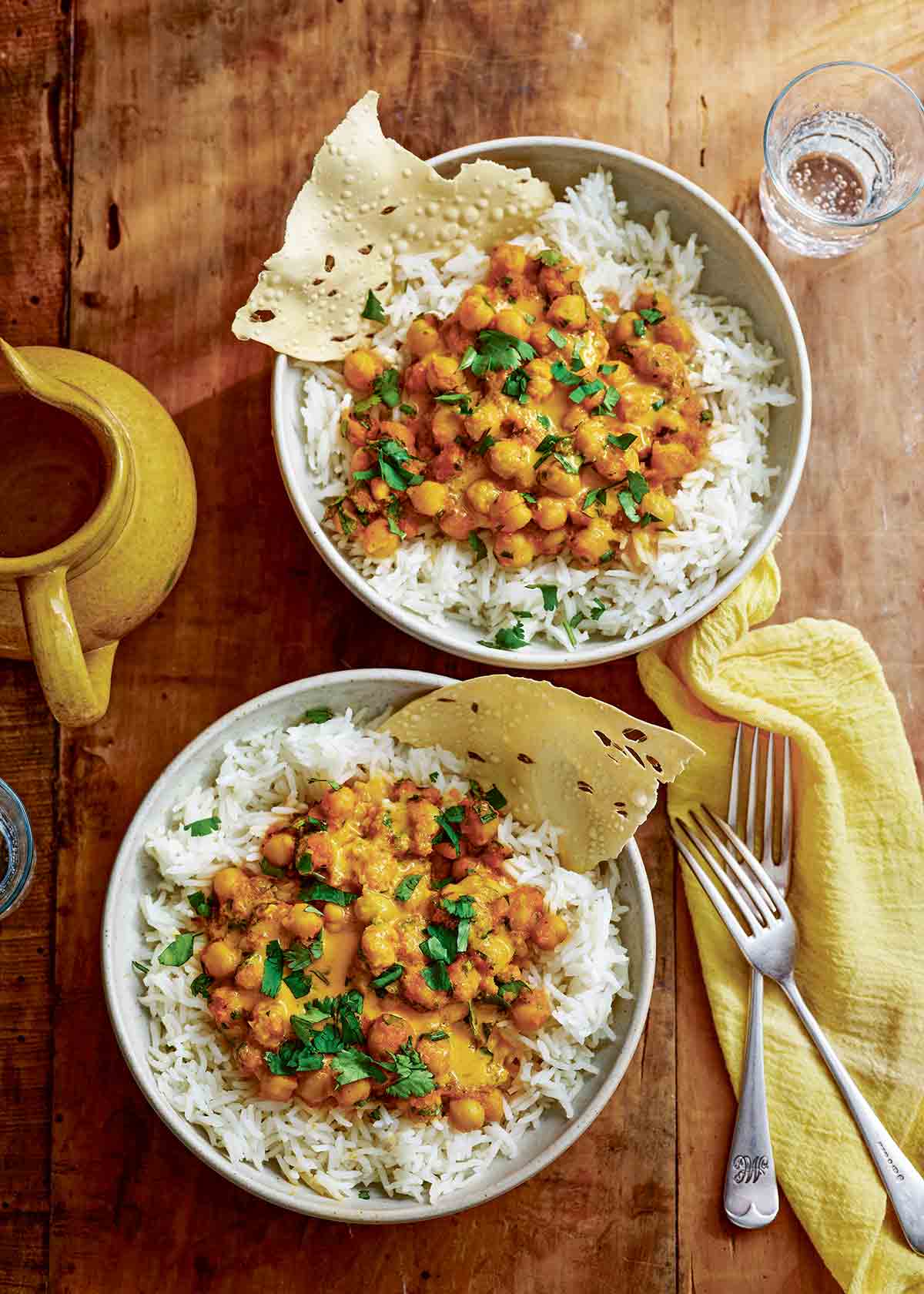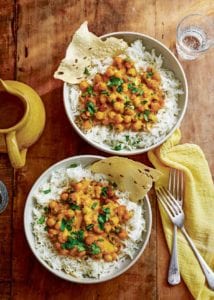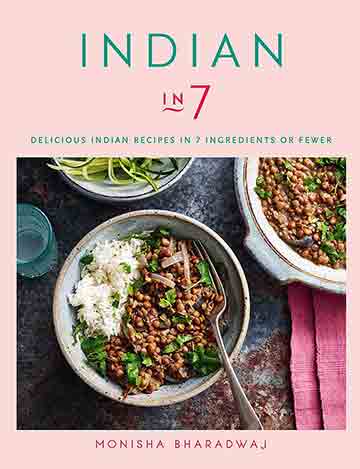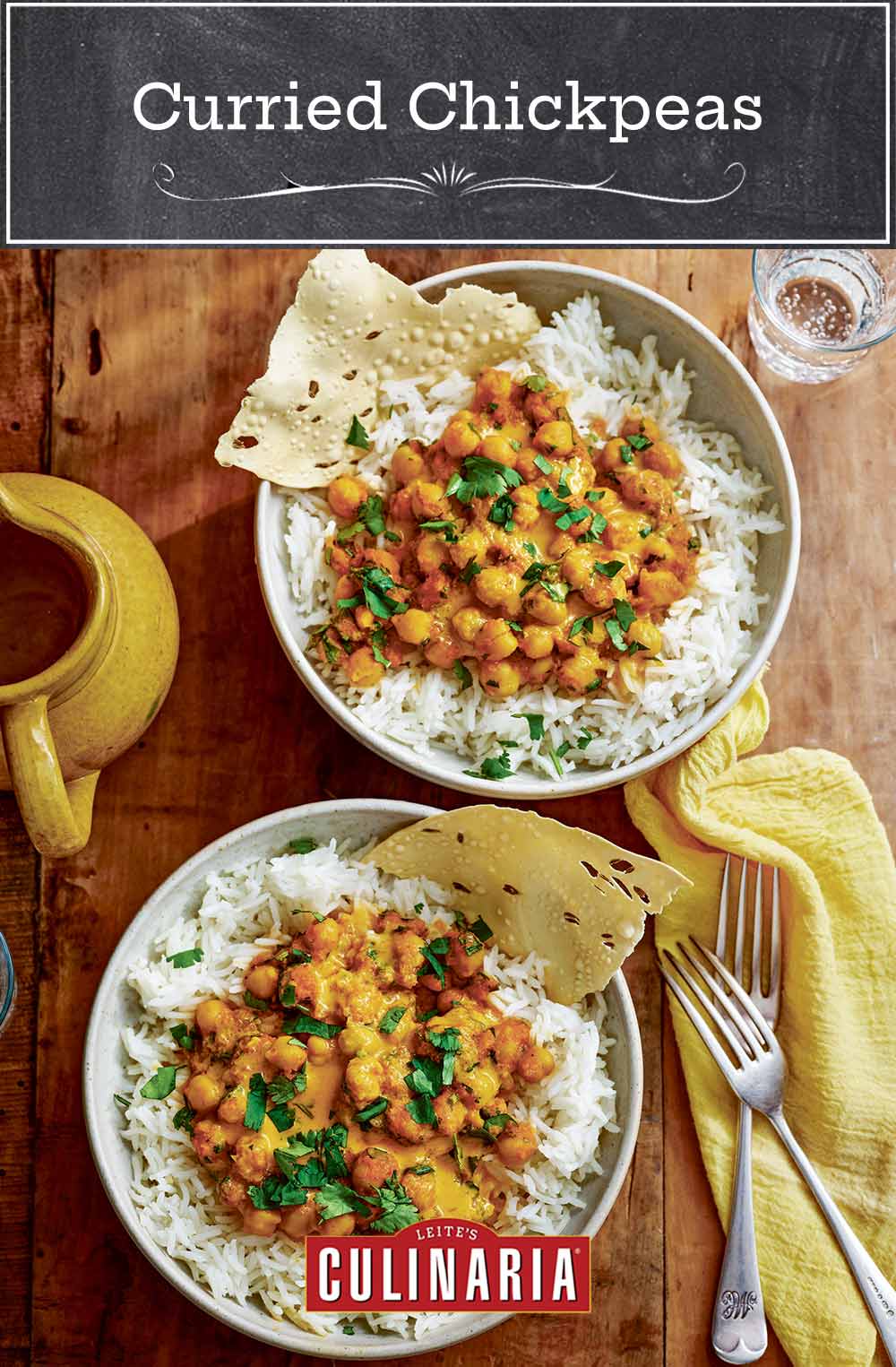
These easy curried chickpeas are a superb back-pocket recipe for busy weeknights. They’re also vegan and gluten-free, though you’d never guess it from the rich, creamy sauce.–Angie Zoobkoff

Curried Chickpeas
Ingredients
For the ginger-garlic paste
- 1 teaspoon grated or minced ginger
- 2 teaspoons grated or minced garlic
For the curried chickpeas
- 3 tablespoons mild vegetable oil
- 2 medium (about 10 oz total) onions, sliced 1/2-inch (12-mm) thick
- 1 tablespoon store-bought or homemade tomato paste
- Cold water
- 1 teaspoon ground turmeric
- 1 teaspoon chili powder* (regular chili powder will work)
- 1 teaspoon ground coriander
- Pinch cayenne pepper (optional)
- One (14-ounce) can chickpeas, drained and rinsed
- Kosher salt
- 2 tablespoons chopped fresh cilantro
- Cooked rice
Instructions
Make the ginger-garlic paste
- In a small bowl, stir together the ginger and garlic, mashing with the back of a spoon to thoroughly combine.
☞ TESTER TIP: If you’re making a larger batch of the ginger-garlic paste to keep a stash on hand, blitz the peeled and chopped ginger and garlic in a blender along with a little cold water to turn the blades until it makes a smooth paste. Scrape it into a clean jar, add enough oil to cover the surface (any oil will do), and keep in the fridge for up to a couple weeks, topping off the oil as needed.
Make the curried chickpeas
- In a heavy-based saucepan over medium-high heat, warm 1 1/2 tablespoons oil and cook the onions, stirring constantly, until they start to turn golden brown, 2 to 5 minutes. Reduce the heat to medium and cook until softened, 6 to 8 minutes more.
- Add the ginger-garlic paste and cook for a few seconds, then add the tomato paste and continue to cook until well blended, about 1 minute more.
- Remove from the heat, carefully move the mixture to a blender or food processor, add enough cold water to just cover the mixture (probably about 1/2 cup), and then blend until smooth.
☞ TESTER TIP: If using a blender, leave the center cap open so the steam from the mixture can release. Otherwise let the mixture cool for a few minutes prior to blending.
- In the same saucepan over high heat, warm 1 1/2 tablespoons oil and add the turmeric, chili powder, coriander, and cayenne, if using. Cook, stirring, until the spices change color, 10 to 15 seconds. Carefully add 3 to 4 tablespoons of cold water to the pan and continue to cook until the water has evaporated, 1 to 2 minutes.
☞ TESTER TIP: You can easily substitute your fave store-bought curry spice blend for the mixed ground spices.
- Add the chickpeas and mix well, then cook until the chickpeas are heated through, 3 to 4 minutes.
- Stir in the sauce from the blender and season with salt. Rinse out the blender with 2 to 3 tablespoons of cold water and add this to the pan as well. Bring to a boil, then reduce the heat, cover, and simmer until heated through, 5 to 6 minutes.
- Garnish with cilantro and serve with rice.
Notes
*What’s the difference between chili powder and chile powder?
If you’re unsure of the difference and end up using the wrong one, you’re going to be pretty surprised with the end results, spice-wise. Chile is just the pepper. Chili is the amalgamation of tomato, beans, spices, and sometimes beef that we all love. And so, chili spice is a powdered mixture of various things—chile pepper, cumin, garlic, onion, paprika, oregano. It can be quite hot but it has more ingredients than just chile peppers.
Explore More with AI
Nutrition
Nutrition information is automatically calculated, so should only be used as an approximation.
Recipe Testers’ Reviews
This is an extremely flavorful curry. It’s thick, not too spicy, and so easy to make. A perfect vegetarian meal with a bowl of coconut rice. Really comforting!
I served this wonderfully spiced vegetarian curry over brown rice with a side of slow-simmered collard greens. I was initially drawn to the recipe because of its cooking method; I’ve made a variety of curries, but this is the first one I’ve cooked where the recipe instructs you to puree the initial sauce until smooth before adding it back to the pot with the spices and chickpeas. The results were creamy without the need to add any cream. I really felt that the results were restaurant-quality!
The ginger-garlic paste really adds a depth of flavor to the sauce; I used a regular chili powder here.
For the garlic paste portion of the recipe, I tried to make just what I needed for the recipe. I used about 1-inch of peeled fresh ginger and 4 peeled garlic cloves. I actually blitzed it in the mini food processor with about 2 tablespoons of water. This method worked very well. The recipe serves 4 people perfectly.
Overall, this is a lovely recipe and the nice thing is most of the ingredients were already in the house. I recommend serving this dish with a dry Riesling or even a glass of dry bubbly.
I can’t imagine growing tired of eating this EVER. The sauce alone is a dream! So fabulously fragrant, so delicious, and oh so quick to make (permission to use canned chickpeas—thank you). I know in the future making this for dinner will often cross my mind on my way home from work.
It’s such an easy recipe to follow, too, as each step is pretty simple and accurately described.
The only thing I did a bit differently is that I processed the fried onions with 1/4 cup water in a jar using an immersion blender.
For the ginger-garlic paste, I used 2 tablespoons of ginger and 4 tablespoons of garlic (6 cloves). I didn’t add any water since I quickly pounded them in a mortar. I was surprised to see them, especially the garlic, dramatically reduce in volume after being completely smashed into a paste. In the end, I had about 3 tablespoons of paste.
The recipe yielded just over 2 cups of chana masala, not nearly enough for us Indian food enthusiasts. (I’m glad I also made spiced brown lentils with red onion to serve alongside it.)
We enjoyed the curry with basmati rice and naan to savor every bit left on the plate.
I think this is a good template on the mild side. I think without some cumin and maybe more “curry” spicing, this was just a bit bland for us. It can easily be adjusted to the flavor level of the cook and will not scare people away from exploring curry as a good weeknight meal.
I could have been happy using any of my other curry blends (Williams-Sonoma coarse grind Madras is another pantry favorite).
I love making the ginger-garlic paste and the onion sauce (including the blending) ahead of time.
The flavor profile was on the mild side and seemed to need a bit of punch, not heat so much as a little more curry depth. Since we were only eating half the batch, I decided to make adjustments the next night, and just offered some lime sambal and chutney on the side as well as salt at the table.
On reheating the next meal, I added a teaspoon of favorite curry spice, another tablespoon of the ginger-garlic mixture, salt, as well as some more vegetables (half a red bell pepper and half a fennel bulb, sliced and diced). The adjusted seasoning was well received, and I would say pick your favorite curry, or maybe just some cumin, and a bit of salt (unless you are serving with a lime pickle, which is super salty). I look forward to making this again, maybe with chickpeas cooked from scratch.
The Vitamix made a quick and perfect puree in about 15 seconds! I added about ¼ cup water to rinse the last bit from the blender and another 1/4 cup of water when reheating leftovers to thin the sauce with the additional vegetables.
I think blooming the spices in oil is a really good basic Indian cooking lesson that this recipe introduces in a simple manner. When I cooked the veggies, I added them to the added spices I bloomed in oil, then in about 5 to 6 minutes, added the leftover chickpea curry leftovers.
The curry was ready in under 20 minutes and was served with jasmine rice.
Spicy, flavorful, and quick—my husband and I loved this recipe. While we ate it hot, I think it would also be wonderful served cold. It’s a great weeknight meal, and since it’s with a shortlist of ingredients that I always have in my pantry, it’s a good one to have on hand. I’ll definitely be making this again.
My only recommendation to save yourself a bit of time is to forego making the garlic ginger paste. Simply add those ingredients to the onions when sauteing because it all gets tossed in the blender anyway.
Chana masala is one of my go-to Indian dishes when dining with a crowd because it’s simple and not too exotic for my friends that aren’t familiar with Indian cuisine. Plus, it’s vegan and can therefore fit several different dietary needs. I’m thrilled to have a recipe I can make myself at home. This dish was flavorful, comforting, and warming for a cold, grey winter day.
I used regular chili powder and added 6 tablespoons of water when blending the onions. I blended for about 2 minutes total. I would strongly advise using a blender or food processor that is vented somehow so steam can freely escape, otherwise you’ll have a lot of built-up pressure which can be dangerous. Something with an opening that can be opened while the machine is running also allows you to add water as the sauce blends. I used my food processor and it worked great.
Overall, really easy to pull together. You could easily add meat if you like.















